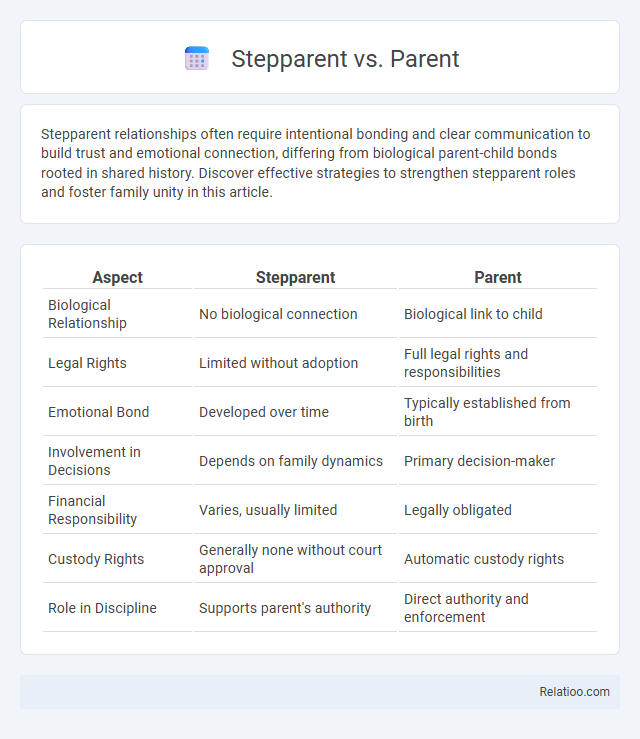Stepparent relationships often require intentional bonding and clear communication to build trust and emotional connection, differing from biological parent-child bonds rooted in shared history. Discover effective strategies to strengthen stepparent roles and foster family unity in this article.
Table of Comparison
| Aspect | Stepparent | Parent |
|---|---|---|
| Biological Relationship | No biological connection | Biological link to child |
| Legal Rights | Limited without adoption | Full legal rights and responsibilities |
| Emotional Bond | Developed over time | Typically established from birth |
| Involvement in Decisions | Depends on family dynamics | Primary decision-maker |
| Financial Responsibility | Varies, usually limited | Legally obligated |
| Custody Rights | Generally none without court approval | Automatic custody rights |
| Role in Discipline | Supports parent's authority | Direct authority and enforcement |
Understanding the Role of a Stepparent vs Parent
Stepparent versus parent role ambiguity often arises from unclear boundaries and expectations in blended families, impacting relationship dynamics. Understanding the stepparent's role involves recognizing their position as an adult caregiver who supports both the child and the biological parent without replacing the biological parent's authority. Effective communication and defined responsibilities help clarify roles, reducing confusion and fostering trust within the family unit.
Legal Rights: Stepparent vs Parent
Stepparent legal rights are generally limited compared to biological or legal parents, as stepparents typically do not have automatic custody or decision-making authority unless they legally adopt the child. Parents retain full legal rights including custody, visitation, and the ability to make medical, educational, and financial decisions for their child. Courts often require explicit legal agreements or adoption for stepparents to gain parental rights, highlighting the importance of clear legal status to avoid role ambiguity.
Emotional Bonds: Navigating Relationships
Stepparent, parent, and role ambiguity significantly influence emotional bonds within blended families, affecting attachment and trust development among children. Clarity in roles and consistent emotional support foster stronger relationships, whereas ambiguity can lead to confusion and insecurity in children's emotional well-being. Understanding these dynamics is crucial for nurturing healthy, supportive connections in complex family structures.
Challenges Faced by Stepparents Compared to Parents
Stepparents often face unique challenges such as establishing authority and building trust in blended family dynamics, which can lead to role ambiguity and conflict unlike biological parents who have a clearly defined role. Unlike biological parents, stepparents may struggle with less societal recognition and legal rights, complicating their ability to discipline or make decisions for stepchildren. Emotional boundaries and loyalty conflicts between children and biological parents also create complexities that stepparents must navigate to foster healthy family relationships.
Communication Strategies for Blended Families
Effective communication strategies in blended families address stepparent, parent, and role ambiguity by fostering open dialogue and clearly defining family roles to reduce confusion and conflict. Establishing consistent family routines and regular family meetings helps members express feelings and expectations, enhancing mutual understanding and cooperation. Emphasizing empathy and active listening creates a supportive environment where stepparents and biological parents collaborate, promoting cohesive family dynamics.
Discipline Differences: Stepparent and Parent Approaches
Discipline differences between stepparents and biological parents often stem from role ambiguity, where stepparents may struggle to establish authority or face resistance from children accustomed to parental rules. Parents typically apply consistent, established disciplinary methods rooted in long-term relationships, while stepparents might adopt either more lenient or stricter approaches to gain respect and maintain harmony. Understanding these dynamics highlights the importance of clear communication and unified strategies to create stable boundaries and effective discipline in blended families.
Building Trust with Stepchildren
Building trust with stepchildren requires consistent communication, patience, and respect for their emotional boundaries. Stepparents must navigate role ambiguity by clearly defining their position without attempting to replace biological parents, fostering a sense of security and acceptance. Emphasizing empathy and reliability helps bridge gaps, promoting healthy relationships amid family structure complexities.
Cultural Perceptions: Stepparent vs Parent
Cultural perceptions of stepparents versus biological parents vary significantly, influencing family dynamics and social acceptance. In many societies, biological parents are seen as primary caregivers with inherent authority, while stepparents often face ambiguity regarding their roles and responsibilities. This cultural distinction impacts legal rights, emotional bonds, and the integration of stepparents into family units, often leading to challenges in clearly defining parental roles.
Step-Sibling Dynamics in Blended Households
Step-sibling dynamics in blended households often involve complex role ambiguity as individuals navigate identities between stepparent, parent, and sibling. Research shows that clear communication and defined boundaries help reduce conflict and promote positive relationships among step-siblings. Studies in family psychology emphasize that supportive co-parenting and mutual respect significantly improve adjustment and emotional well-being in these blended family systems.
Tips for Healthy Co-Parenting and Blended Family Success
Establish clear boundaries and open communication to reduce stepparent vs parent vs role ambiguity in blended families, ensuring each adult understands their responsibilities and respect is mutual. Consistently involve Your child in conversations about family roles to promote security and avoid confusion, fostering trust and emotional stability. Prioritize collaboration and empathy among all adults, which supports healthy co-parenting dynamics and overall blended family success.

Infographic: Stepparent vs Parent
 relatioo.com
relatioo.com